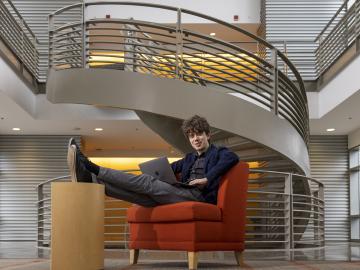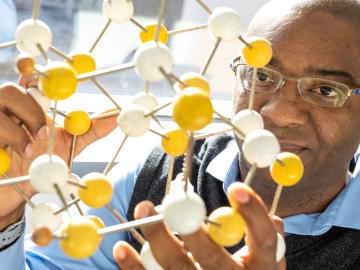
Filter News
Area of Research
- (-) Clean Energy (78)
- (-) Materials (34)
- Advanced Manufacturing (1)
- Biology and Environment (44)
- Chemistry and Physics at Interfaces (1)
- Data (1)
- Energy Frontier Research Centers (1)
- Functional Materials for Energy (1)
- Fusion and Fission (7)
- Isotope Development and Production (1)
- Isotopes (9)
- Materials Synthesis from Atoms to Systems (1)
- Materials Under Extremes (1)
- National Security (16)
- Neutron Science (8)
- Nuclear Science and Technology (5)
- Renewable Energy (1)
- Sensors and Controls (1)
- Supercomputing (9)
News Type
News Topics
- 3-D Printing/Advanced Manufacturing (10)
- Big Data (1)
- Bioenergy (3)
- Biology (1)
- Biomedical (1)
- Buildings (6)
- Chemical Sciences (2)
- Clean Water (1)
- Climate Change (2)
- Computer Science (1)
- Coronavirus (4)
- Critical Materials (1)
- Cybersecurity (2)
- Decarbonization (8)
- Energy Storage (12)
- Environment (7)
- Fusion (1)
- Grid (6)
- Materials (5)
- Materials Science (7)
- Mathematics (1)
- Mercury (1)
- Microscopy (4)
- Nanotechnology (4)
- National Security (1)
- Net Zero (1)
- Neutron Science (3)
- Nuclear Energy (2)
- Physics (6)
- Polymers (2)
- Quantum Computing (1)
- Security (2)
- Summit (1)
- Sustainable Energy (6)
- Transportation (10)
Media Contacts

Systems biologist Paul Abraham uses his fascination with proteins, the molecular machines of nature, to explore new ways to engineer more productive ecosystems and hardier bioenergy crops.

Joe Hagerman, ORNL research lead for buildings integration and controls, understands the impact building technology innovations can have during times of crisis. Over a decade ago, he found himself in the middle of one of the most devastating natural disasters of the century, Hurricane Katrina.

Ada Sedova’s journey to Oak Ridge National Laboratory has taken her on the path from pre-med studies in college to an accelerated graduate career in mathematics and biophysics and now to the intersection of computational science and biology

In the search to create materials that can withstand extreme radiation, Yanwen Zhang, a researcher at the Department of Energy’s Oak Ridge National Laboratory, says that materials scientists must think outside the box.

While some of her earth system modeling colleagues at ORNL face challenges such as processor allocation or debugging code, Verity Salmon prepares for mosquito swarms and the possibility of grizzly bears.

In the Physics Division of the Department of Energy’s Oak Ridge National Laboratory, James (“Mitch”) Allmond conducts experiments and uses theoretical models to advance our understanding of the structure of atomic nuclei, which are made of various combinations of protons and neutrons (nucleons).

Ilias Belharouak is leading ORNL’s research efforts in investigating new materials for solid-state batteries, which can double the charging capacity of lithium-ion batteries, commonly used today for electronic devices such as cell phones.

Joe Paddison, a Eugene P. Wigner Fellow at the Department of Energy’s Oak Ridge National Laboratory, believes there’s more information to be found in neutron scattering data than scientists like himself might expect.

Valentino (“Tino”) Cooper of the Department of Energy’s Oak Ridge National Laboratory uses theory, modeling and computation to improve fundamental understanding of advanced materials for next-generation energy and information technologies.

Peter Wang is focused on robotics and automation at the Department of Energy’s Manufacturing Demonstration Facility at ORNL, working on high-profile projects such as the MedUSA, a large-scale hybrid additive manufacturing machine.


